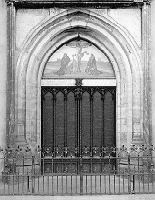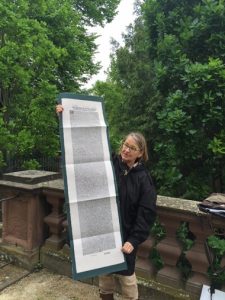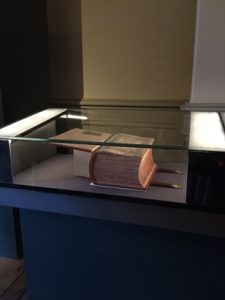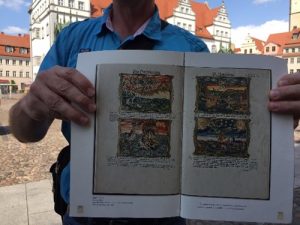REFORMATION PILGRIMAGE TESTIMONY: OF MAN, MACHINE AND MOVEMENT (II)
S M Wong
The Turning Point of Modern History
According to Protestant historian Philip Schaff in the History of the Christian Church, “The Reformation of the sixteenth century is, next to the introduction of Christianity, the greatest event in history. It marks the end of the Middle Ages and the beginning of modern times”.
It was against this backdrop that Martin Luther nailed his 95 theses to the church door, hoping to invite a public discussion on the truth about indulgences. No one accepted the challenge, and no discussion took place.

Door of the Castle Church in Wittenberg
But God did not remain silent. As the Chief Strategist, he was moving the right chess pieces to defend His Word and Work in His own good time. And it is in God that we should trust. According to our guide, one of Luther’s students smuggled the theses out, got it copied, translated and printed in Basel. It went viral – fast and wide. Without copyright or censorship, the pamphlets were spread all over Germany and Europe within weeks. The lay people who could not read were absorbed by the public reading of the theses. The theses gained traction because it was a reflection of the people’s plight.
The break with Rome came on January 3, 1521 when the pope excommunicated Luther. He was practically declared a heretic. But Luther had powerful allies in the person of Frederick III, the Elector of Saxony who pressured Emperor Charles V not to outlaw Luther without a hearing.

The Edict of Worms
And so Luther was summoned to the Diet of Worms to recant his teachings. Instead of repentance, the journey to Worms was almost like a victory march. Luther was given a hero’s welcome by the people who lined the streets. Indeed, he had no reasons to recant when he said, “Unless I am convicted by Scripture and plain reason – I do not accept the authority of popes and councils, for they have contradicted each other – my conscience is captive to the Word of God. I cannot and will not recant anything, for to go against conscience is neither right nor safe. God help me. Amen”
In the language of the millennials, Luther was so dead. The Emperor issued the Edict of Worms (as tall if not taller than our local guide. See photo) and Luther was made an outlaw. What this means is that he could be killed by anyone without being punished.
On the trip home, the Elector of Saxony allowed Luther to be kidnapped on May 4. Luther was hidden in Wartburg Castle (1521-22) under the disguise of “Squire George”.
It was in Wartburg Castle that Luther translated the German New Testament in 11 weeks. This formed the foundation of the first complete German Bible which was ready in 1533 and the first edition was printed in 1534.

1st Edition of Luther’s German Bible
Luther was both an evangelist and a linguist who set the gold standard for High German in his translation. The people read the Bible not only to know the Truth but to learn the language. But the cost of the Bible (one cow and a pig, according to our guide) was beyond the means of the majority. Their solution – buy in pages according to their budget. Even if they could afford the pages, most were not literate. This was when Lucas Cranach’s woodcut drawings became useful. To me, the first German Bible was the first serialised comic strip and textbook.

Cranach’s Drawings in Early German Bibles
According to Philip Schaff, Luther made the Reformation and the Reformation made him. By my own yardstick, Luther was the original superstar – a giant slayer of his times.
Whither the Reformation?
The Reformation Pilgrimage was a journey on God’s Providence. Very often, we are too focused on our trials and tribulations that we do not wait for or see God’s big picture for us.
I am reminded to trust God and not men because they are not perfect. While Erasmus was critical of the abuses within the Church and called for reform, he kept his distance from Luther and continued to recognise the authority of the pope.
Even men of courage and conviction whom God raised can fail us. Luther was anti-semitic (albeit not in the racist sense) when he failed to convert the Jews.
Ulrich Zwingli (1484–1531) was a leader of the Reformation in Switzerland. He persecuted the Anabaptists (one who baptizes again) to protect the nascent Reformation movement. The Anabaptists (the Amish are direct descendants) rejected infant baptism and believed in baptizing converts again even though they had been baptized as infants. Felix Manz and five others were drowned in the River Limmat in Zurich. Pastor explained when there was no separation between state and religion, the consequence was much confusion.
The Reformation Pilgrimage was also a journey to guard our hearts from turning stone cold. We saw many monuments and I am reminded that they are meaningless if the legacy of the reformers does not live on in our hearts.
The saddest part of the pilgrimage was at the site in Constance where Huss was burnt at the stake in 1415 where he prayed, “Lord Jesus, it is for thee that I patiently endure this cruel death. I pray thee to have mercy on my enemies.”
I found myself asking the question, “What did he die for? And to what end?”
The Bethlehem Chapel where he once preached was converted from a Protestant to Catholic church in 1661 by the Jesuits. It was desecrated and demolished in 1786. What we saw on the pilgrimage was a reconstruction in the 1950s. According to the Czech Republic’s 2011 census, 34.2% of the population had no religion, 10.3% was Roman Catholic and 0.4% belonged to the Czechoslovak Hussite Church, tracing its roots to John Huss.
As a church, we must pray that we will be a living church, not a monument. We must pray for FEBC to raise up more men and women who will start a revival in wherever they are called to serve. Above all, I see the need to document the Bible-Presbyterian movement. Future generations must know where we came from, what we are and why we are defending His Word, lest we forget.
On the last day of the pilgrimage, we had devotions in the Reformed Evangelical Church in Grindelwald, Switzerland. Pastor reminded us that the pilgrimage may be coming to an end, we continue as pilgrims in our sojourn here. As our voices soared to the high heavens (the acoustics in the church
is exquisite) singing “Great is Thy Faithfulness”, I am reminded I can and should do better as a Christian until I touch the face of God.
To God be the glory!


